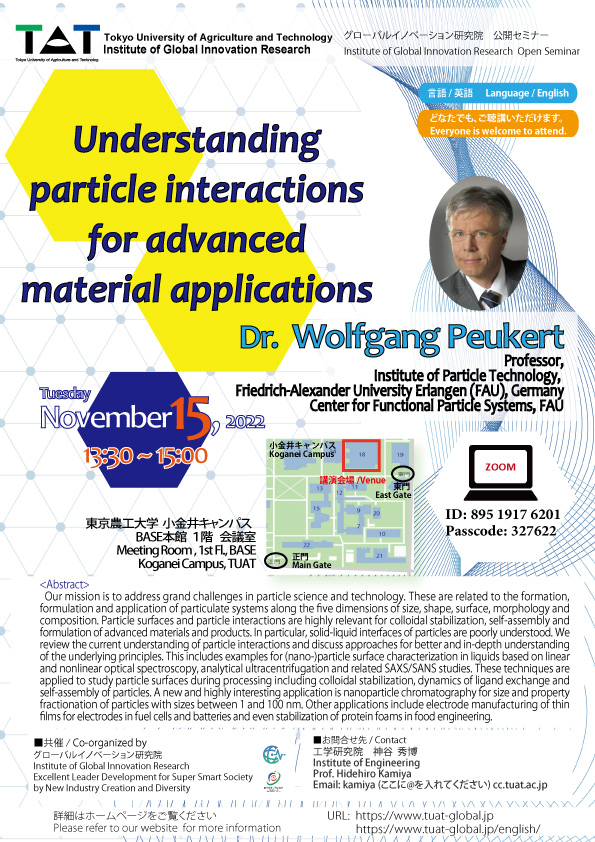日時:2022年11月15日(火) 13:30~15:00
会場:小金井キャンパス BASE棟一階会議室 Zoomでもご参加いただけます。
https://tuat-jp.zoom.us/j/89519176201?pwd=SG9jWHNtbmVjT3VZQ3lhTEdLOGc1UT09
ミーティングID: 895 1917 6201 パスコード: 327622
◆講演者
Dr. Wolfgang Peukert(ドイツ、フリードリヒ・アレクサンダー大学、Friedrich-Alexander-University of Erlangen-Nürnberg, Institute of Particle Technology、教授)
◆講演タイトル
“Understanding particle interactions for advanced material applications”

<要旨>
Our mission is to address grand challenges in particle science and technology. These are related to the formation, formulation and application of particulate systems along the five dimensions of size, shape, surface, morphology and composition. Particle surfaces and particle interactions are highly relevant for colloidal stabilization, self-assembly and formulation of advanced materials and products. In particular, solid-liquid interfaces of particles are poorly understood. We review the current understanding of particle interactions and discuss approaches for better and in-depth understanding of the underlying principles. This includes examples for (nano-)particle surface characterization in liquids based on linear and nonlinear optical spectroscopy, analytical ultracentrifugation and related SAXS/SANS studies. These techniques are applied to study particle surfaces during processing including colloidal stabilization, dynamics of ligand exchange and self-assembly of particles. A new and highly interesting application is nanoparticle chromatography for size and property fractionation of particles with sizes between 1 and 100 nm. Other applications include electrode manufacturing of thin films for electrodes in fuel cells and batteries and even stabilization of protein foams in food engineering. 私たちの使命は、微粒子科学技術の大きな課題に取り組むことである。これらは、サイズ、形状、表面、形態および組成の5次元に沿った粒子系の形成、配合および適用に関連している。粒子表面と粒子相互作用は、コロイドの安定化、自己組織化、先進的な材料や製品の定式化に非常に関連している。特に、粒子の固液界面はあまり理解されていない。粒子間相互作用の現在の理解をレビューし、基礎となる原理をより良く深く理解するためのアプローチを議論する。これには、線形および非線形光学分光法、分析超遠心法および関連するSAXS/SANS研究に基づく液体中の (ナノ) 粒子表面の特性評価の例が含まれる。これらの技術は、コロイド安定化、配位子交換の動力学、粒子の自己集合を含む処理中の粒子表面の研究に適用される。新しく非常に興味深い用途は、1から100 nmの間のサイズを持つ粒子のサイズおよび特性分画のためのナノ粒子クロマトグラフィーである。他の用途としては、燃料電池や電池の電極用薄膜の電極製造、食品工学におけるタンパク質フォームの安定化などがある。